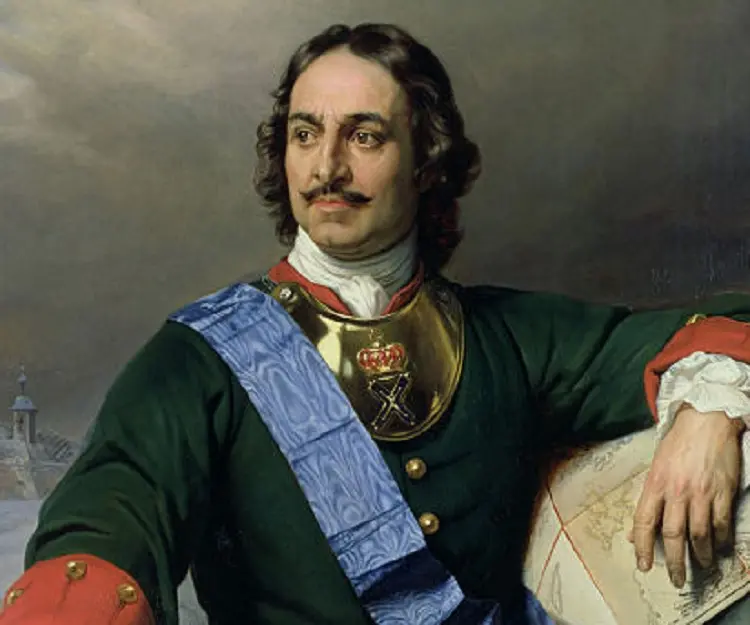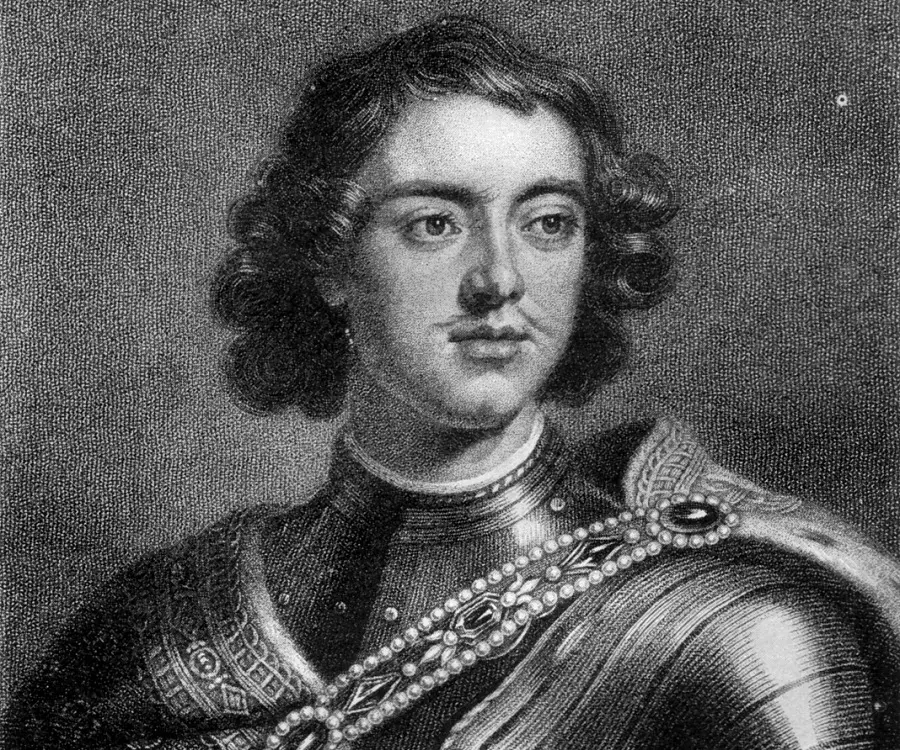
Peter the Great - Emperors, Facts and Childhood
Peter the Great's Personal Details
Peter the Great was the Tsar and first Emperor of Russia known for his extensive expansion and reforms
| Information | Detail |
|---|---|
| Birthday | June 9, 1672 |
| Died on | February 8, 1725 |
| Nationality | Russian |
| Famous | Historical Personalities, Emperors & Kings, ESFP, Emperors, First Emperor of Russia, Kings |
| Nick names | Peter the Great, Peter I, Pyotr Alexeyevich |
| Spouses | Catherine I of Russia, Eudoxia Lopukhina, Maria Cantemir |
| Siblings | Feodor III of Russia, Ivan V of Russia, Sofia Alekseyevna of Russia |
| Known as | Peter the Great, Peter I, Peter Alexeyevich |
| Childrens | Elizabeth of Russia |
| Founder / Co-Founder |
|
| Birth Place | Moscow |
| Religion | Russian Orthodox Church, Eastern Christianity, Orthodox Christianity |
| Height | 203 |
| Gender | Male |
| Father | Alexis of Russia |
| Mother | Natalya Naryshkina |
| Sun Sign | Gemini |
| Born in | Moscow |
| Famous as | First Emperor of Russia |
| Died at Age | 52 |
// Famous Kings
Sundiata Keita
Sundiata Keita was the founder of the Mali Empire in West Africa. This biography profiles his childhood, early life, struggles, founding of empire, rule, administration, achievements and also gives some fun facts.
Ashoka
Ashoka was the third emperor of the Mauryan Dynasty and ruled almost the entire Indian subcontinent. This biography profiles his childhood, life, reign, achievements and timeline
Murad IV
Murad IV was one of the mighty Sultans in the history of the Ottoman Empire. This biography profiles his childhood, family, accession, rule, administration and timeline.
Peter the Great's photo
Who is Peter the Great?
Peter the Great was a Russian Tsar in the late 17th century who later on became the first Emperor of Russia. A very powerful ruler, he was famous for engaging in numerous military campaigns in order to expand his Tsardom into a large empire. Born as the 14th child of Tsar Alexis by his second wife, he was forced to shoulder the responsibilities of Tsardom from an early age. Tsar Alexis died when Peter was just four, and the deceased Tsar was succeeded by Peter’s elder half-brother, Feodar III. Feodar was a sickly youth and he died after a few years, leaving behind no legitimate sons. This gave rise to a dispute over who should inherit the throne. The next in line for the throne was another one of Peter’s elder half-brothers, Ivan V. However, Ivan was chronically ill and not viewed as a suitable ruler, so Peter, aged just 10, was chosen to become Tsar with his mother as regent. For a few years he ruled jointly with his brother Ivan and after Ivan’s death in 1696, Peter became the sole ruler. As ruler, Peter expanded his territories greatly and implemented several radical reforms in order to make Russia a great country and a major power in Europe
// Famous Emperors
Sundiata Keita
Sundiata Keita was the founder of the Mali Empire in West Africa. This biography profiles his childhood, early life, struggles, founding of empire, rule, administration, achievements and also gives some fun facts.
Ashoka
Ashoka was the third emperor of the Mauryan Dynasty and ruled almost the entire Indian subcontinent. This biography profiles his childhood, life, reign, achievements and timeline
Murad IV
Murad IV was one of the mighty Sultans in the history of the Ottoman Empire. This biography profiles his childhood, family, accession, rule, administration and timeline.
Childhood & Early Life
He was born as Pyotr Alekseyevich on June 9, 1672 in Moscow, Russia, as the son of Tsar Alexis and his second wife, Natalya Kirillovna Naryshkina. He was his father’s 14th child but his mother’s first son. Most of his elder half-siblings were weak and sickly while Peter himself was healthy and full of energy and vigor.
The Tsar Alexis died when Peter was just four years old. His elder half-brother, Feodar III succeeded to the throne. Feodar was a sickly person and he died in 1682.
Another ill half-brother, Ivan V, inherited the throne. But since Ivan was also sickly and of infirm mind, the Russian nobles chose the healthy ten-year-old Peter to become Tsar with his mother as regent. From 1682, the two brothers Ivan and Peter ruled jointly.
Ascension & Reign
Ivan died in 1696 and Peter was officially declared Sovereign of all Russia. When Peter came to power, Russia was severely underdeveloped as compared to the other European nations which were prosperous and culturally rich. Russia lagged behind in modernization and this was something Peter vowed to change.
He implemented a series of progressive reforms during his reign in an attempt to bring Russia at par with the other European nations. He reorganized his army according to Western standards, and invited experts in the fields of shipbuilding, engineering, architecture and business from all over Europe to come to Russia and help modernize the country. He also encouraged the Russians to move out to different parts of Europe for furthering their education.
Industrial development was boosted in an unprecedented way during the reign of Peter. He encouraged the Russians to adopt the latest European technologies and this led to a surge in the number of factories being built. Trade and commerce flourished during his reign.
Peter realized that it was important to make Russia a maritime power in order to make trading with other nations easier. He sought to create more maritime outlets and after several wars with Turkey in the south, he secured access to the Black Sea. He officially founded the first Russian Navy base, Taganrog, in September 1698.
He also embarked on extensive military campaigns in order to expand his territories. He started the Northern War with Sweden in 1700. The city of St. Petersburg was founded (1703) on the delta of the Neva River during the course of the war and in 1712 Peter the Great moved the Russian capital from Moscow to St. Petersburg which prospered as a hub of trade and culture.
The war went on for 21 long years and ended with the Treaty of Nystad in 1721. By the time the war ended, Russia had acquired Ingria, Estonia, Livonia, and a substantial portion of Karelia. After the end of the Northern War in 1721, Russia was declared an Empire and Peter the Great proclaimed himself its Emperor.
His later reign too was marked by several radical reforms. In 1722, Peter created a new order of precedence known as the Table of Ranks. The Russian Orthodox Church was also reformed during his reign.
Major Works
Peter the Great is famous as the ruler under whose administration Russia became a great European nation. He implemented several reforms to modernize Russia. Among other things, he focused on the development of science and technology, encouraged trade and commerce, secularized schools and modernized the Russian alphabet, introduced the Julian calendar, and established the first Russian newspaper.
Personal Life & Legacy
When Peter was a young man, his mother arranged his marriage with Eudoxia Lopukhina, the daughter of a minor noble. The marriage which took place in 1689 was unhappy from the very beginning. Peter divorced his wife in 1698 and forced her to join a convent. This union produced three children.
A few years after his divorce, he took a mistress by the name Martha Skavronskaya who converted to the Russian Orthodox Church and took the name Catherine. He married her in Saint Petersburg on 9 February 1712. This marriage resulted in the birth of 11 children though only a few survived to adulthood.
Peter the Great began having problems with his urinary tract and bladder in 1723. He had a surgery in 1724 though his heath started failing again soon after. He died on February 8, 1725, without nominating an heir.
Peter the Great biography timelines
- // 9th Jun 1672He was born as Pyotr Alekseyevich on June 9, 1672 in Moscow, Russia, as the son of Tsar Alexis and his second wife, Natalya Kirillovna Naryshkina. He was his father’s 14th child but his mother’s first son. Most of his elder half-siblings were weak and sickly while Peter himself was healthy and full of energy and vigor.
- // 1682The Tsar Alexis died when Peter was just four years old. His elder half-brother, Feodar III succeeded to the throne. Feodar was a sickly person and he died in 1682.
- // 1682Another ill half-brother, Ivan V, inherited the throne. But since Ivan was also sickly and of infirm mind, the Russian nobles chose the healthy ten-year-old Peter to become Tsar with his mother as regent. From 1682, the two brothers Ivan and Peter ruled jointly.
- // 1689 To 1698When Peter was a young man, his mother arranged his marriage with Eudoxia Lopukhina, the daughter of a minor noble. The marriage which took place in 1689 was unhappy from the very beginning. Peter divorced his wife in 1698 and forced her to join a convent. This union produced three children.
- // 1696Ivan died in 1696 and Peter was officially declared Sovereign of all Russia. When Peter came to power, Russia was severely underdeveloped as compared to the other European nations which were prosperous and culturally rich. Russia lagged behind in modernization and this was something Peter vowed to change.
- // Sep 1698Peter realized that it was important to make Russia a maritime power in order to make trading with other nations easier. He sought to create more maritime outlets and after several wars with Turkey in the south, he secured access to the Black Sea. He officially founded the first Russian Navy base, Taganrog, in September 1698.
- // 1700 To 1712He also embarked on extensive military campaigns in order to expand his territories. He started the Northern War with Sweden in 1700. The city of St. Petersburg was founded (1703) on the delta of the Neva River during the course of the war and in 1712 Peter the Great moved the Russian capital from Moscow to St. Petersburg which prospered as a hub of trade and culture.
- // 9th Feb 1712A few years after his divorce, he took a mistress by the name Martha Skavronskaya who converted to the Russian Orthodox Church and took the name Catherine. He married her in Saint Petersburg on 9 February 1712. This marriage resulted in the birth of 11 children though only a few survived to adulthood.
- // 1721The war went on for 21 long years and ended with the Treaty of Nystad in 1721. By the time the war ended, Russia had acquired Ingria, Estonia, Livonia, and a substantial portion of Karelia. After the end of the Northern War in 1721, Russia was declared an Empire and Peter the Great proclaimed himself its Emperor.
- // 1722His later reign too was marked by several radical reforms. In 1722, Peter created a new order of precedence known as the Table of Ranks. The Russian Orthodox Church was also reformed during his reign.
- // 1723Peter the Great began having problems with his urinary tract and bladder in 1723. He had a surgery in 1724 though his heath started failing again soon after. He died on February 8, 1725, without nominating an heir.
// Famous Historical Personalities
Sundiata Keita
Sundiata Keita was the founder of the Mali Empire in West Africa. This biography profiles his childhood, early life, struggles, founding of empire, rule, administration, achievements and also gives some fun facts.
Ashoka
Ashoka was the third emperor of the Mauryan Dynasty and ruled almost the entire Indian subcontinent. This biography profiles his childhood, life, reign, achievements and timeline
Jetsun Pema
Jetsun Pema is the Queen consort of Bhutan. Check out this biography to know about her childhood, family life, achievements and fun facts about her life.
Murad IV
Murad IV was one of the mighty Sultans in the history of the Ottoman Empire. This biography profiles his childhood, family, accession, rule, administration and timeline.
Xerxes I
Xerxes I (Xerxes the Great) was the fourth and the most famous king of the Archaemenid dynasty of Persia. This biography profiles his childhood, family, personal life, life history, achievements, campaigns, administration, death and other facts.
Sargon of Akkad
Sargon of Akkad, also called ‘Sargon the Great’, ‘Sarru-Kan’ and ‘Shar-Gani-Sharri’, was the founder and first king of the Akkadian Empire. This biography profiles his childhood, life, rule, administration, timeline, and gives some fun facts.
Peter the Great's FAQ
What is Peter the Great birthday?
Peter the Great was born at 1672-06-09
When was Peter the Great died?
Peter the Great was died at 1725-02-08
Where was Peter the Great died?
Peter the Great was died in Saint Petersburg
Which age was Peter the Great died?
Peter the Great was died at age 52
Where is Peter the Great's birth place?
Peter the Great was born in Moscow
What is Peter the Great nationalities?
Peter the Great's nationalities is Russian
What is Peter the Great nick names?
Peter the Great's nickNames is Peter the Great, Peter I, Pyotr Alexeyevich
Who is Peter the Great spouses?
Peter the Great's spouses is Catherine I of Russia, Eudoxia Lopukhina, Maria Cantemir
Who is Peter the Great siblings?
Peter the Great's siblings is Feodor III of Russia, Ivan V of Russia, Sofia Alekseyevna of Russia
Who is Peter the Great childrens?
Peter the Great's childrens is Elizabeth of Russia
Which company or organization was founded by Peter the Great?
Peter the Great was the founder/co-founder of Russian Navy, Saint Petersburg State University
What is Peter the Great's religion?
Peter the Great's religion is Russian Orthodox Church, Eastern Christianity, Orthodox Christianity
How tall is Peter the Great?
Peter the Great's height is 202.99999999999997
Who is Peter the Great's father?
Peter the Great's father is Alexis of Russia
Who is Peter the Great's mother?
Peter the Great's mother is Natalya Naryshkina
What is Peter the Great's sun sign?
Peter the Great is Gemini
How famous is Peter the Great?
Peter the Great is famouse as First Emperor of Russia








